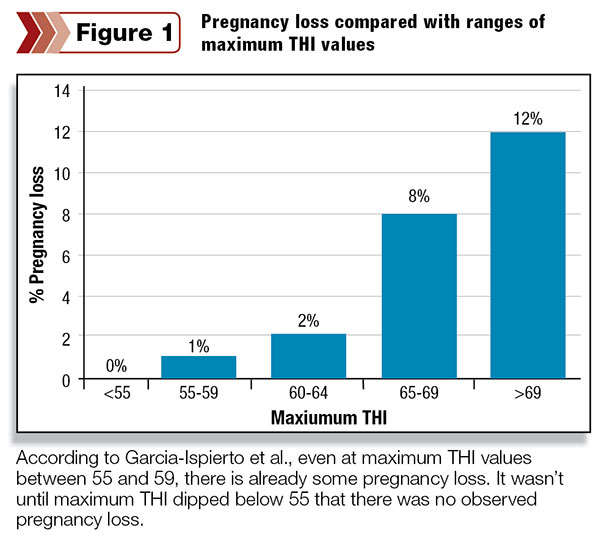It has been estimated that economic losses related to heat stress in production animals could account for as much as $900 million annually. With this type of financial loss, it is not surprising that dairy producers and their consultants are continually trying to incorporate strategies and management techniques to minimize the negative effects of heat stress.
In order to manage heat stress, we have to be able to measure heat stress. One of the measures of heat stress that has proven to be effective in identifying potential production losses is the use of the temperature-humidity index (THI).
The THI equation is relatively straightforward. It accounts for the ambient temperature and the relative humidity to determine an index which assesses the actual effect of heat stress.
Although the incorporation of THI in livestock production was not really promoted until the early 1990s, the concept has been recognized for considerably longer. Researchers started applying the equation to estimate cooling requirements of dairy cattle as early as 1964.
Despite the straightforward equation, the interpretation of THI can sometimes be confusing. A good way to demonstrate this is to think of two different regions that are affected by heat stress.
Both regions have identical heat abatement facilities and management techniques. The first region has a maximum THI of 100 during the day and a nighttime low of 60.
Meanwhile, the second region does not get as hot during the day, with a maximum THI of 80. However, it does not cool down during the evening, and thus the minimum THI is still 80.
Despite having a higher maximum THI, cow performance could potentially be greater in the first region than in the second region because the lower nighttime THI allows cows a chance to recover at the lower THI value.
This example is not intended to question the value of the THI calculation but to recognize that the THI calculation needs to be interpreted carefully when determining how it could affect performance.
THI and animal performance
The next logical question should be “At what THI does animal performance really start to decrease?” The previously established cooling guidelines suggest that animal performance is adversely affected by a THI of 72.
An evaluation of test-day records indicated that for each unit increase in THI greater than 72 (when calculated based on maximum temperature and minimum humidity), daily milk yields decreased by 0.44 pounds.
Research suggested even greater milk yield losses. Those researchers compared milk production loss and THI measures under heat-stress conditions in Arizona or Georgia. They reported threshold THI values of 72 in Georgia and 75 in Arizona, with an average loss of 0.86 pounds of milk per THI unit in Georgia and 0.48 pounds of milk per THI unit in Arizona.
Besides providing support for milk loss related to THI, it also reinforces the previous example of carefully interpreting THI based on different types of heat-stress conditions.
More recent research has provided evidence that animal performance is negatively affected at THI values much less than 72. In fact, data now indicates that dairy cows producing more than 77 pounds of milk per day are negatively affected when minimum THI is greater than 65 or when average THI is 68 for more than 17 hours per day.
Why the difference? Today’s high-producing dairy cow is metabolically quite different from those cows which were used when developing the original THI standard. Cows used in the original THI research were producing approximately 50 to 60 pounds. The intake (and heat associated with metabolism) is much less than today’s typical high-producing dairy cow.
For example, an increase in milk production from 40 to 70 pounds results in a 177 percent increase in heat production because of the extra heat generated from increased metabolism.
In addition to production losses, THI has shown a strong correlation to some reproductive measures. Many of the negative responses are related to changes in blood flow and production of various reproductive hormones. This can eventually cause early embryonic death, inhibition of follicular dominance and reduced ovarian steroidogenic output.
The relationship between THI and early embryonic death was investigated in a research paper in 2006. The aim of their research was to establish whether THI values from days one to 40 of gestation could be associated with pregnancy loss in dairy cows.
Data from 1,391 pregnancies were evaluated, and pregnancies were determined by trans-rectal ultrasonography. Maximum THI was used to evaluate heat stress and was calculated using the daily maximum ambient temperature and the minimum relative humidity.

Figure 1 illustrates the pregnancy loss rates compared with ranges of maximum THI values during days 21 to 30 of gestation.
What is interesting in this data is that even at maximum THI values of between 55 and 59, there was already some pregnancy loss. It wasn’t until maximum THI values dipped below 55 that there was no observed pregnancy loss.
As stated by the authors: “The likelihood of pregnancy loss increased by a factor of 1.05 for each unit increase in mean maximum THI from days 21 to 30 of gestation.” The significance of these losses cannot be overstated. In addition to losing the pregnancy, additional time is also required until the next heat cycle.
THI values are a valuable tool for producers and nutritionists to use when managing the negative effects of heat stress. However, researchers are continuing to learn more about the impacts of THI on dairy cows.
Based on recent reports, it is clear that high-producing dairy cattle are already affected at THI values much less than the traditional threshold value of 72. It is more likely negative effects on production are occurring when the THI is 68 and negative effects on reproduction when THI is as low as 55.
It is recommended that dairy producers measure THI values based on the conditions inside the barn, not the general weather report for the area. Contact your local representative to learn more about the tools available to track THI and manage the impact of heat stress on the dairy herd. PD
References omitted due to space but are available upon request. Click here to email an editor.

-
Stu Rymph, Ph.D.
- Dairy Nutritionist
- Purina Animal Nutrition Livestock Technical Support Group
- Email Stu Rymph, Ph.D.






